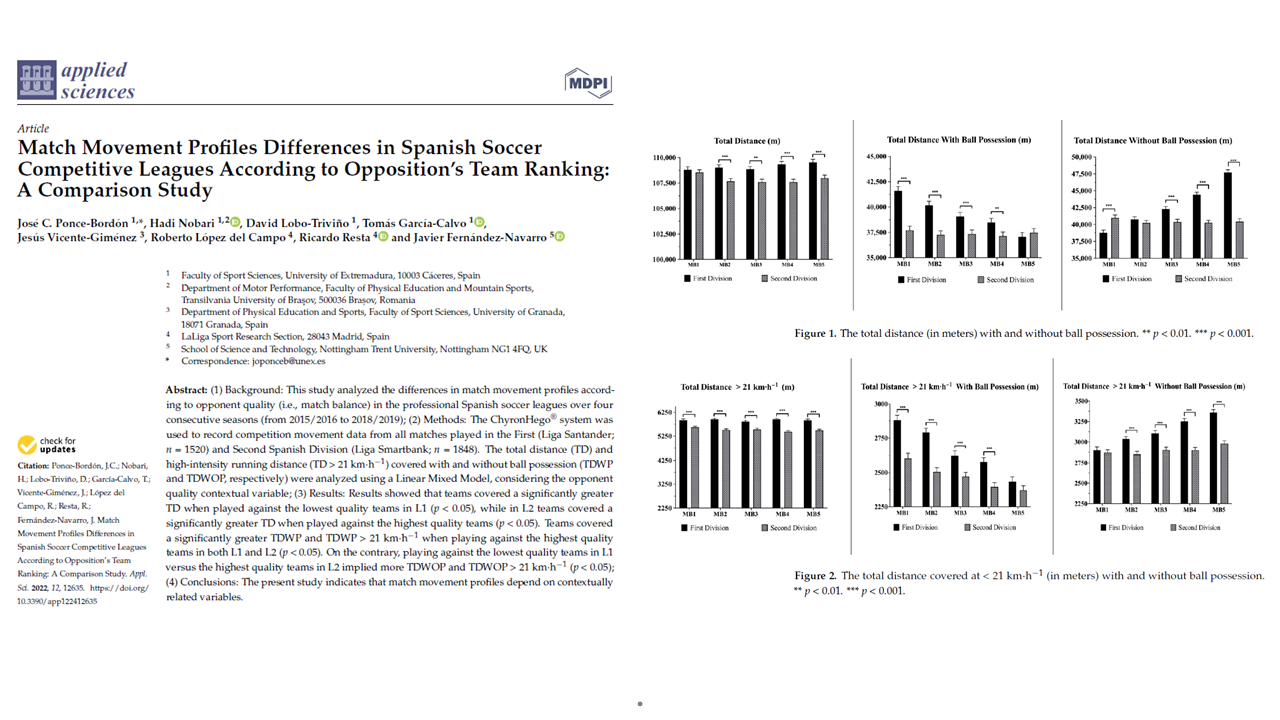
09 Dic Match Movement Profiles Differences in Spanish Soccer Competitive Leagues According to Opposition’s Team Ranking: A Comparison Study
Plain-English summary with practical takeaways for first-team staff
When you face a strong opponent, your team tends to cover more distance with the ball—including more high-speed running with possession (>21 km·h⁻¹). Against weaker opponents, in LaLiga (First Division) teams typically rack up more distance without the ball—including more high-speed work out of possession—despite overall control of the game. These patterns were derived from 3,368 matches across four seasons (2015/16–2018/19) using the TRACAB (Mediacoach) system, tracking total distance and sprinting, split with vs. without possession.
Why it matters for your week plan
- Load truly depends on opponent quality (“match balance”).
In LaLiga (L1), total distance was highest vs. the lowest-ranked opponents; with-ball work peaked vs. top teams, and without-ball high-speed work peaked vs. bottom teams. In LaLiga SmartBank (L2), patterns were more mixed: with-ball distances were also higher vs. top teams, without-ball total distance was higher vs. top teams, while without-ball sprinting (>21 km·h⁻¹) peaked vs. bottom teams (see Tables 1–2 and Figures 1–2). - Translation to training: you should periodize with-ball vs. without-ball exposures based on the next opponent’s level, and adjust recovery after matches with unusually high WOP (without possession) or WP (with possession) loads.
How to apply this week (coachable actions)
- If the next opponent is much stronger (MB1):
- Plan MD-4/MD-3 to emphasize high-speed running with the ball: wave games 6v6/7v7 to full goals, transition finishing, possession at pace.
- Tactical: scripted press-resist build-up and counter-press to regain so that with-ball high-speed demands you’ll face on match day are already “pre-paid”.
- Conditioning cue: HSR with ball (20–40 m entries) embedded in tactical tasks. applsci-12-12635-v2
- If the next opponent is much weaker (MB5, especially in L1):
- Expect more WOP volume and high-speed WOP despite leading—think longer defensive transitions, recovery runs, and cover sprints.
- Plan MD-3 for defensive transition repeats (e.g., 8–12 × 30–40 m cover sprints from compact block) and deep-block → counter scenarios.
- Recovery: post-match use eccentric-biased lower-limb recovery and hamstrings care after high WOP sprint counts. applsci-12-12635-v2
- Balanced opponents (MB3):
- Mix WP/WOP high-speed exposures; small-sided for density, then open-field runs to ensure sprint entries in both phases.
- Match-prep: toggle press height and rest-defence spacing to keep WOP sprints under control.
League-specific nuances you can exploit
- First Division (L1): higher overall total distance and high-speed than L2 across most match-balance bands; ensure weekly speed-exposure and with-ball high-speed are not under-dosed. (See Figure 2 for >21 km·h⁻¹ differences.)
- Second Division (L2): be ready for higher WOP total distance vs. top opponents, but note that WOP sprinting may spike vs. bottom teams—monitor this to avoid unexpected hamstring load late in the microcycle. (Table 2 / Figure 2.)
Practical checklist for staff
- Scout → Plan: classify the next match as MB1–MB5 (ranking gap).
- Dose the right phase:
- MB1: bias to with-ball HSR, controlled possession at pace, counter-press.
- MB5 (L1): bias to WOP sprints, recovery runs, long-pass/counter cover.
- Monitor: split GPS/optical metrics by WP vs. WOP so you don’t misread the load.
- Recover: tailor recovery to the dominant phase (e.g., more eccentric hamstring work after high WOP sprint exposure). applsci-12-12635-v2
Limitations to remember
Only two physical metrics were analysed (TD and >21 km·h⁻¹) and data are from Spanish professional leagues; style and score effects can modulate these patterns. Use the framework, then overlay your team’s tactical context.


